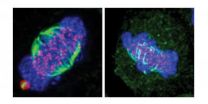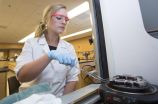Space lab to elucidate how liquid cocktails mix
Zero-gravity experiments can tell us a great deal about the effects of temperature change on the concentrations of 3 different liquids that are mixed together
2015-05-11
(Press-News.org) What does space experimentation have in common with liquid cocktails? Both help in understanding what happens when multiple fluids are mixed together and subjected to temperature change - a phenomenon ubiquitous in nature and industrial applications such as oil fluids contained in natural reservoirs. The latest experimental data performed in zero gravity on the International Space Station is now available in the newly published Topical Issue of EPJ E. The results constitute the first set of highly accurate and broadly validated data on the thermodiffusion effects that occur when three different liquids are mixed. Such experiments were made possible by a collaboration of space agencies including the ESA, NASA, CSA and ROSCOSMOS.
The problem under scrutiny is scientifically much more complex than it may appear. The thermodiffusion mechanism - also called the Soret effect - is the product of an imposed temperature difference and leads to concentration differences within a mixture. The trouble is that it is that because it is a weak effect, it is still poorly understood, 150 years after its discovery.
Until now studies have focused on mixes of two liquids. But the liquids found in nature, as well as in cocktails and in industrial applications usually contain more than just two components. This has produced a shift in research to multicomponent systems.
New measurements in this series of studies stem from six different teams, which were then compared and averaged out. The teams performed parallel measurements of the Soret coefficient of the same mixtures containing three different liquids. To counter difficulties in measurement due to thermal instabilities and changes in solubility, the teams performed experiments in space, where gravitational effects are dramatically reduced. They then repeated them on the ground. The result: a benchmark of the Soret effect in ternary liquid mixtures, which will guide future theoretical and numerical models.
INFORMATION:
References: Benchmark values for the Soret, thermodiffusion and molecular diffusion coefficients of the ternary mixture tetraline+isobutylbenzene+n-dodecane with 0.8-0.1-0.1 mass fraction. M. M. Bou-Ali, A. Ahadi, D. Alonso de Mezquia, Q. Galand, M. Gebhardt, O. Khlybov, W. Köhler, M. Larrañaga, J. C. Legros, T. Lyubimova, A. Mialdun, I. Ryzhkov, M. Z. Saghir, V. Shevtsova, S. Van Varenbergh (2015), Eur. Phys. J. E 38: 30, DOI 10.1140/epje/i2015-15030-7
Topical Issue: 'Thermal non-equilibrium phenomena in multi-component fluids', F. Croccolo and H. Bataller (2015), Eur. Phys. J. E
ELSE PRESS RELEASES FROM THIS DATE:
2015-05-11
MADISON -- Mike Graham knows that fluid dynamics can reveal much about how the flow of blood helps and hinders individual blood cells as they go about their work.
Graham, the Vilas Distinguished Achievement Professor and Harvey D. Spangler Professor of Chemical and Biological Engineering at UW-Madison, established a theoretical basis for these ideas by creating complex computer stimulations that show how relatively stiff white blood cells and platelets interact with more flexible red blood cells. As the different cells collide during blood flow, white cells tend to be ...
2015-05-11
Volcanoes are considered chaotic systems. They are difficult to model because the geophysical and chemical parameters in volcanic eruptions exhibit high levels of uncertainty. Now, Dmitri V. Alexandrov and colleagues from the Ural Federal University in Ekaterinburg, in the Russian Federation, have further extended an eruption model -- previously developed by other scientists -- to the friction force at work between the volcanic plug and volcanic conduit surface. The results, published in EPJ B, provide evidence that volcanic activity can be induced by external noises that ...
2015-05-11
Chinese scientists have reared beef rich in the beneficial fatty acids associated with fish oils. The study in Springer's journal Biotechnology Letters also highlights the scientific challenges that remain.
The team from Northwest A&F University and the National Beef Cattle Improvement Centre, both in Yangling (Shaanxi), successfully introduced a gene into foetal cells from Luxi Yellow cattle, a Chinese breed with a high beef yield. The fat1 gene, isolated from a nematode worm, codes for desaturase enzymes that are involved in the conversion of n-6 to n-3 polyunsaturated ...
2015-05-11
How much food your dining companion eats can have a big influence on how much you consume, a UNSW Australia-led study concludes.
This psychological effect, known as social modelling, leads people to eat less than they normally would if alone when their companion consumes a small amount of food.
Study lead author, Associate Professor Lenny Vartanian of the UNSW School of Psychology, says that in social situations the appropriate amount of food to eat can be unclear.
"Internal signals like hunger and feeling full can often be unreliable guides. In these situations people ...
2015-05-11
An international consortium of scientists led by a group from the University of Leicester has announced a new advance in understanding the mechanisms of cancer and how to target it more effectively with new treatments.
Two papers published in the same issue of the world-leading Journal of Cell Biology have arisen from research work led by Professor Andrew Fry at the University of Leicester. Both papers suggest that new understanding of the mechanics of cell division can reveal new targets for cancer therapy.
Professor Fry, who is Director of Research in the College ...
2015-05-11
Geoscientists have, for the first time, discovered the origins of Australia's two largest basins: Lake Eyre and the Murray-Darling Basin. The research also implies that in 30 million years' time both basins will cease to exist.
Monash University geoscientist Associate Professor Wouter Schellart, and his colleague Professor Wim Spakman from Utrecht University, have discovered how the floor of an entire ocean basin that was destroyed 70 to 50 million years ago off the North coast of New Guinea is currently located at 800-1200km depth below Central and South-eastern Australia.
Using ...
2015-05-11
New scanning methods which map the wiring of the brain could provide a valuable new tool to predict people at risk of schizophrenia, according to a new study.
Scientists have long known that the symptoms of schizophrenia are partly explained by disordered connectivity in the brain.
Now, a team of scientists from Cardiff University Brain Research Imaging Centre (CUBRIC), the Institute of Psychiatry, Psychology and Neuroscience, Kings College London and the University of Bristol, have, for the first time, used Magnetic Resonance Imaging (MRI) to identify how the ...
2015-05-11
Myopia or short-sightedness is becoming more common across Europe, according to a new study led by King's College London. The meta-analysis of findings from 15 studies by the European Eye Epidemiology Consortium found that around a quarter of the European population is short-sighted but it is nearly twice as common in younger people, with almost half (47 per cent) of the group aged between 25 and 29 years affected.
The analysis of studies covering over 60,000 people, which was published today in the journal Ophthalmology, also found a strong link between myopia and level ...
2015-05-11
New research suggests the use of hookah steam stones - commonly considered a safer alternative to cigarette smoking - could be leaving users with a dangerous, false sense of security. The findings out of the University of Cincinnati/Agilent Technologies Metallomics Center of the Americas are published this month in the Microchemical Journal.
An analysis led by Amberlie Clutterbuck, a doctoral student in the UC Department of Chemistry, found residues of toxic metals that included chromium, arsenic and cadmium following several simulated hookah/steam stones smoking scenarios.
Clutterbuck's ...
2015-05-11
Philadelphia, PA, May 11, 2015 -- Dopamine is the chemical messenger in the brain most closely associated with pleasure and reward. Recent scientific advances now shed light on precise roles for dopamine in the reward process.
A new paper published in the current issue of Biological Psychiatry implicates dopamine in a person's ability to be motivated by delayed rewards.
People like immediate reinforcement and tend to devalue rewards that are substantially delayed in time. As a result, people will often opt for smaller immediate rewards as opposed to larger delayed rewards ...
LAST 30 PRESS RELEASES:
[Press-News.org] Space lab to elucidate how liquid cocktails mix
Zero-gravity experiments can tell us a great deal about the effects of temperature change on the concentrations of 3 different liquids that are mixed together

